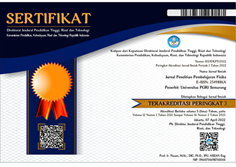Assessment of Abiotic Factors for Sea Turtle Nesting Suitability in Coastal Bays
DOI:
https://doi.org/10.26877/asset.v6i4.998Keywords:
nesting-ecology, abiotic-factors, conservation,, ecological-assessment, habitat-suitabilityAbstract
Cilacap Bays, critical nesting areas for sea turtles, face growing habitat disturbances from tourism. However, studies on nesting suitability in these regions remain scarce. This research assesses the abiotic factors influencing sea turtle nesting in Cilacap Regency, Indonesia, across eight observation stations. Key ecological parameters—land surface temperature (28°C - 36.3°C), pH (mean 6.8), sand particle size (0.212-0.500 mm), beach slope (11.50%-20.99%), and beach width (28.8m-81.8m)—were evaluated. The results highlight Sidaurip Beach as the most suitable for nesting due to optimal environmental conditions, with Station (SP1) being particularly favorable for producing male hatchlings due to its suitable 28°C temperature. These findings suggest targeted egg relocation to SP1 could help address gender imbalances, ensuring long-term population sustainability. This research provides valuable insights for sea turtle conservation and supports future policy efforts to protect nesting sites in Cilacap amidst growing environmental pressures
References
Abreu-Grobois, A. and Plotkin, P. (IUCN SSC Marine Turtle Specialist Group). 2008. Lepidochelys olivacea. The IUCN Red List of Threatened Species 2008: e.T11534A3292503. https://dx.doi.org/10.2305/IUCN.UK.2008.RLTS.T11534A3292503.en. Accessed on 07 September 2024.
Dharmawan, L., 2020. The story of a young man who is struggling to “save turtles” in Cilaca p - starting from spending his own money, "hiding" eggs, to making captives. Jakarta: BBC NEWS Indonesia.
Wood, D. W. & Bjorndal, K.A. 2000. Relation of temperature, moisture, salinity, and slope to nest site selection in loggerhead sea turtles. Copeia 2000(1): 119-128. doi:10.1371/journal.pone.0015465
Kamel, S.J. & Mrosovsky, N. 2004. Nest site selection in leatherbacks, Dermochelys coriacea: Individual patterns and their consequences. Anim. Behav. 68(2): 357-366. doi:10.1016/j.anbehav.2003.07.021
Budiantoro, A., Retnaningdyan, C., Hakim, L. & Leksono, A.S. 2019. Characteristics of olive ridley (Lepidochely olivacea) nesting beaches and hatcheries in Bantul, Yogyakarta, Indonesia. Biodiversitas 20 (11): 3119-3125. https://doi.org/10.13057/biodiv/d201103
Ewert, M.A. and Nelson, C.E. 1997. Sex determination in turtles: diverse patterns and some possible adaptive values. Copeia, 1991, pp.50-69.
Hamann, M., Godfrey, M., Seminoff, J., Arthur, K., Barata, P., Bjorndal, K. and Godley, B.J. 2010. Global research priorities for sea turtles: Informing management and conservation in the 21st Century. Endangered Species Res., 11(3), pp.245-269.
Kamel, S.J. & Mrosovsky, N. 2005. Repeatability of nesting preferences in the hawksbill sea turtles, Eretmochelys imbricata, and their fitness consequences. Anim. Behav. 70(4): 819-828. doi:10.1016/j.anbehav.2005.01.006.
Tripathy, B. & Rajasekhar, P.S. 2009. Natural and anthropogenic threats to olive ridley sea turtles (Lepidochelys olivacea) at the Rushikulya rookery of Orissa coast, India. Indian J Mar. Sci. 38 (4): 439-443.
Natih, N.M., Pasaribu, R.A., Hakim, M.A., Budi, P.S. & Tasirileleu, G.F., 2021. Olive ridley (Lepidochelys olivacea) laying eggs habitat mapping in Penimbangan Beach, Bali Island. Earth Environ. Sci., 944(01): 20-38. DOI: 10.1088/1755-1315/944/1/012038
Peričić, T.P. and Tanveer, S., 2019. Why systematic reviews matter. www.elsevier.com/connect/authors-update/whysystematic-reviews-matter (accessed February 2023).
Ngabito, M., Fahrizal, A., Umsini, M.Y., Polimango, E. A. & Ningsi, A., 2021. The biophysical characteristics of Sea Turtles Spawning Beaches: a study in Mas Popaya Raja Nature Reserve. The International Journal Journal of Social Sciences World 3(1): 210-217. DOI: https://doi.org/10.5281/zenodo.5032478
Mathenge, S.M., Mwasi, B.N. & Mwasi, S.M. (2012). Effects of anthropogenic activities on seaturtle nesting beaches along the Mombasa-Kilifi Shoreline Kenya. Marine Turtle Newsletter 135: 14-18. http://www.seaturtle.org/mtn/archives/mtn135/mtn135p14.shtml?nocount
Nuitja, I.N.S. 1992. Biologi dan Ekologi Pelestarian Penyu Laut. Buku: Institut Pertanian Bogor Press, Bogor
Damanhuri, H., Dahemi, Syandri, H. & Bengen, D.G. 2019. Biophysical Characteristics of Nesting Habitat of Green Turtle Chelonia Mydas in the Coastal Zone of Kasiak, Bindalang, and Karabak Ketek Island of West Sumatra, Indonesia. Int’l J. of Agric. Sci. 3(2): 44-49. DOI: 10.25077/ijasc.3.2.44-49.2019
Drake, D.L. and Spotila, J.R. 2002. Thermal Tolerances and The Timing of Sea Turtle Hatchling Emergence. Journal of Thermal Biology 27(1) 71 - 81. DOI: 10.1016/S0306-4565(01)00017-1
Agus, D.I., Nyoman, S.N., Dedi, S., Matheus, H.H., Mirza, D. K., Syamsul, B. L., Rofi, A.M., Khazali.Mimi, M., Poppi, L.W., Setiabudiningsih, and Ali, M. 2009. Pedoman teknis pengelolaan konservasi penyu. Direktorat Konservasi dan Taman Nasional Laut, Direktorat Jenderal Kelautan, Pesisir dan Pulau-Pulau Kecil, Departemen Kelautan dan Perikanan RI.
Hawkes, L.A., Broderick, A.C., Godfrey, M.H., Godley, B.J. & Witt. M.J. 2014. Coastal Conservation. Cambridge University Press, Cambridge: 310 hlm.
Kawagoshi, T., Uno, Y., Nishida, C. & Matsudaa, Y. 2014. The Staurotypus Turtles and Aves Share the Same Origin of Sex Chromosomes but Evolved Different Types of Heterogametic Sex Determination. PLoS ONE 9(8): e105315. https://doi.org/10.1371/journal.pone.0105315
Laloë, J.O., Cozens, J., Renom, B., Taxonera, A. and Hays, G.C. 2014. Effects of rising temperature on the viability of an important sea turtle rookery. Nat. Clim. Change 4: 513-518. DOI: 10.1038/nclimate2236
Lutz, P.L., Musick, J.A. & Wynekken, J. 2003. The Biology of Sea Turtles Volume II (Florida: CRC Press).
Colin, J. L. 2009. A Biological Review of Australian Marine Turtles. EnvironmentalProtection Agency Queensland Government.
Segara, A.R. 2008. Studi Karakteristik Biofisik Habitat Peneluran Penyu hijau (Chelonia mydas) di Pangumbahan Sukabumi, Jawa Barat, Bachelor Thesis, Faculty of Fisheriesand Marine Science, IPB University.
Pertiwi, M.P. & Lathifah, S.S. 2018. Conditions of hilling habitat of Chelonia mydas (Green Turtle) in Pangumbahan Beach Ujung Genteng, Sukabumi Selatan. Journal of Sci. Innovare 1(2): 2615-3769. DOI: 10.33751/jsi.v1i02.1003
Panjaitan, R.A.and Iskandar, S.A.H. 2012. Hubugan Perubahan garis pantai terhadap habitat bertelur penyu hijau (Chelonia mydas) di pantai Pangumbahan Ujung Genteng, Kabupaten Sukabumi. Jurnal Perikanan dan Kelautan 3(3): 311-320
Ekanayake, E.M.I., Rajakaruna, R.S., Kapurusinghe, T., Saman, M.M., Rathnakumara, D.S., Samaraweera, P. & Ranawana, K.B. 2010. Nesting behaviour of the green turtle at Kosgoda Rookery, Srilanka. Cey. Journal Science (Biological Science) 39(2): 109—120. doi:10.4038/cjsbs.v39i2.2997
Anshary, M., Setyawati, T.R. & Yanti, A.H. 2014. Karakteristik pendaratan penyu hijau (Chelonia mydas, Linnaeus 1758) di pesisir pantai Tanjung Kemuning Tanjung Api dan Pantai Belacan Kecamatan Paloh Kabupaten Sambas. Protobiont 3(2): 232-239. DOI: https://doi.org/10.18343/jipi.28.2.192











